Elephants roaming around in Iran?
Why not?
Fathali Ghahremani Ghajar
January 4, 2007
iranian.com
“It ain't what you don't know that gets you into trouble. It's what you know for sure that just ain't so."
-- Mark Twain
Recently I read an article from an associate that got me all riled up about preconceptions and misconceptions of our world-view. So, I decided to take on a preconception: the idea that elephants were not native to the Middle East in historic times and were all imported from India. While it is quite apparent that there are no elephants in the Middle East today, was it always so? Were the elephants discussed in the literature of the area and shown in ancient artwork and documents of the Middle East all imported from India? Is this “common historical knowledge” accurate? Or is this a case of “… what you know for sure that just ain’t so.”
***
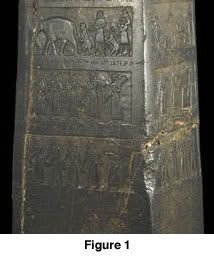
Post Ice Age, according to zoologists, elephants (not mammoths) roamed around Asia and North Africa. They were numerous and varied with four distinct physical types: the dwarf elephants that were about the size of a large dog, pygmy elephants that were about six to eight feet tall and the present African and Indian elephants that exceed ten feet (in some cases as much as thirteen feet) in height. Currently, there are three confirmed species of elephants, one in Africa, one in India and a newly confirmed one (a pygmy elephant) on the Island of Borneo (1).
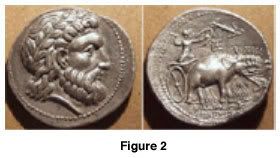
The Borneo elephant has been identified as a separate species; a similar elephant found in Africa has not yet been classified. The African small elephants population, although not as well documented as the East Asia/Borneo population, may also be a separate species. These “new African” elephants are smaller than known Indian/African elephants; some have referred to them as “pygmy elephants”, forest elephants, Loxodonta pumilio, Loxodonta cyclotis, etc. (2). Physically they are described as:
1. About 2 to 2.5 meters (6.5- 8 feet) tall at the shoulder
2. Bulky body with the highest point behind the head
3. The back is straight or slightly upward bowed
4. Skin color is dark gray brown to reddish brown
5. Their hair is more profuse, finer and softer
6. They have five toes
7. Highly variable tusk development
8. The sloping forehead
9. Ears are round, obtuse, large, and do not meet behind the head
10. The trunk has two appendages on the tip, one larger than the other
11. Tail is round and thin with hair on the end in some cases reach the ground
12. Most likely habitats are forests and swamps. (3)
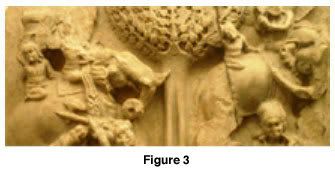
So what does this have to do with elephants in the Middle East? While elephants are known to thrive in a variety of climates from deserts to forests, the natural habitat of all varieties of current elephants is very different from the modern Middle East. In fact it is so different that it is difficult to imagine that such animals could have roamed wild in the region.
Yet, as late as 1400 AD the Middle East had a very different environment. Prior to that time, the region was forested with a very different fauna and flora, a habitat that may have been conducive to harboring herds of elephants. Given the records and graphic art from the period it is highly likely that these were pygmy elephants. It is true that some artistic and poetic license must be allowed; however, the consistent small depiction of the animal over time and across geographical borders can form a basis for this assumption. It should also be noted that, except in the palace of Alalakah in Palestine, no fossil remains have been documented for these elephants. (This may be an area for future research).
Historical records (if not fossil) confirm the existence of elephants in the region. During the time King Iarim-Lim (1775-1760 BC) of Babylonia, "there were herds of elephants in northern Syria, and tusks have been found in the palace of Alalakah..." (4). Later, King Thutmose III (1464 BC) of Egypt in his raids into Palestine and Syria, records capturing “horses” and “elephants” as part of the war booty (5). With the rise of the Assyrian Empire in Syria, there are inscriptions from an Assyrian King Tiglath-Pileser I (ruled 1100 BC) stating: "I hunted and killed ten powerful male elephants in the country of Harran and on the banks of the Chaboras. I also captured alive four elephants; and brought the hides and the tusks of the ten, together with the live elephants, to my city Asshur." (6) It should be noted that Harran is located in what is now South East Turkey and the Chaboras River is a tributary of the Euphrates River flowing from Turkey through Syria, in western Asia. While this text does not describe the physical characteristic of the elephants, it does give an indication of their relative abundance in the region.
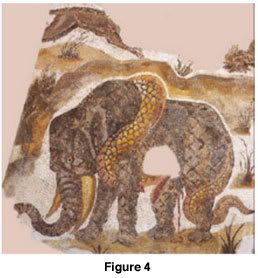
The image of the elephant on The Black Obelisk of Shalmaneser III, (Assyrian king reigned 858– 824 BC) (7) is quite obvious (Figure 1). This Obelisk is a record of the tribute of the peoples of western Asia (not India) to the king and includes images of camels, oryx, rhinoceros, etc. (Inscription “The tribute of the country of Muzri: camels with double backs, an ox of the river ‘Saceya, horses, wild asses, elephants, and apes: I received.” (Muzri was probably located north of Syria) (8) What is interesting is the size and shape of the elephant (9). The tribute bearers and animal handlers are drawn fairly accurately relative to the other animals so the relative size of the elephant may also be correct.
By 331 BC, according to Arrian (92-175 AD), Alexander defeated the Iranian army in Battle of Gaugamela even though they had a few elephants (12-15 animals) (10). Shortly thereafter, Alexander also routed the Indians at the battle of Hydaspes (326 BC) despite a contingent of 200 elephants fielded by King Porus. Interpretations of Arrian’s works in modern times have led to the assumption that elephants in both battles were identical (specially in the absence of any known elephant population in the Middle East).
While serious writers of history question this assumption, the myth that all elephants used in the Middle East originated in India became quite prevalent. Today this myth continues and it is generally assumed that, at least for the Iranian army, all elephants were of Indian origin. However artwork, written histories and poetry of the period indicates otherwise.
The Seleucid kings after Alexander, Seleucus III Soter (225–223 BC) and Antiochus the Great (223–187 BC), minted coins with elephants pulling Apollo in a chariot (11). As shown in the Seleucid coin from 323 BC the elephants are full-grown as can be noted from the tusks (Figure 2) (12). The shoulder height and as well as the relative size of the charioteer to the elephants strongly suggests that the elephants were pygmies similar to the Black Obelisk rather than of Indian origin. These Seleucid elephants are depicted very differently than their counter parts in India as seen in the high relief sculpture dating 200 AD (Figure 3).
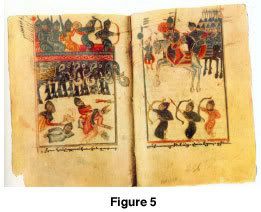
The Mara’s assault on Buddha high relief stone carving (Figure 3) from second century from South Central India clearly depicts the Indian elephant -note that the head is higher than the shoulders. The size of the rider relative to the elephant, as well as his riding stance, is critical. The warrior is clearly squatting on the back of the animal and he is quite small relative to the elephant.(13)
Elephants also appear in Roman literature during the Punic wars (264-146 BC) with Carthage. Roman historians have, documented Hannibal’s crossing of the Alps with elephants in 218 BC in the Second Punic War. They also attribute the Roman victory at the battle in Zama (202 BC) to their ability to force the elephants to stampede into on the Carthaginian troops.
As early as 99 BC there are stories of elephants being used in gladiatorial spectacles. Pompey in a burst of extravagance had twenty elephants killed in a single exhibition. The display was so offensive to the population that a number of Roman writers, such as Plutarch and Cicero, protested the event.
Pliny the Elder, in 77 AD, who also protested the use of elephants in spectacles, devotes a considerable amount of effort to describing elephants, even recounting fights between elephants and snakes. This was depicted in the Dermach Hunting Mosaic from Carthage that shows a full-grown elephant fighting a boa constrictor (Figure 4) (14). Other animal depictions in the Dermach collection are fairly accurate, so, from this mosaic one can conclude that either boa constrictors were considerably larger during Roman times or else the elephants were smaller (even though the reference –not Pliny-calls them Indian elephants). Note that, characteristic of the pygmy elephant; the shoulder is higher than the head.
Both Plutarch in 100 AD and Claudius Aelianus 175-235 AD describe elephants with various details; however, neither gives a sense of the actual size of the animal. (15) Besides, it has been recorded that elephants existed in North Africa until 400 AD when they were apparently hunted to extinction. (16)
Thus all animals described by the Romans were probably either a North African breed (now known to be extinct) or a variation of “Middle Eastern” pygmy elephants (17). It is highly unlikely that elephants described by these authors would be imported from India to be slaughtered for a gladiatorial display. None of the sources give detailed descriptions of physical size of the elephants other than “large” or “massive” (which raises the question “large” or “massive” compared to what, a horse?).

Some one hundred years later, during the reign of Theodosius the Great (390AD), Flavius Vegetius Renatus wrote his famous book, De Re Militari (18), on Roman military organization. This work details the order of battle of the Roman army and has an entire chapter devoted to tactics for confronting elephants. (Book III of De Re Militari, the chapter on “Armed Chariots and Elephants” specifies the battle plan of the Romans for dealing with armies equiped with elephants.)
Renatus did not think much of battle elephants, considered them poor fighters, of little use in combat except for shock value and did not include elephants in the Roman order of battle. Still, he devoted a whole chapter to fighting elephants indicating the importance of the subject to Romans in their battles with the Iranians, their principal eastern enemies.
Renatus did not identify the origins of the elephants. His only physical description is “Elephants by their vast size, horrible noise and the novelty of their form…” scare troops. They were effective for shock and awe against the enemy rather than battlefield control and the Iranian army definitely used elephants to create fear in enemy troops.
Ammianus Marcellinus (325-395 AD), the Roman historian of the Iranian wars, briefly mentions elephants. He tells of the attack on Amida, a city north Nineveh on the Tigres River by the Sassanid king, Shahpour, which he personally witnessed. He describes the event as “…with them (the Sassanid army), making a lofty show, slowly marched lines of elephants, frightful with their wrinkled bodies and loaded with armed men, a hideous spectacle, dreadful beyond every form of horror, as I have often declared.” (19) Shock and awe was indeed the order of the day in this battle.
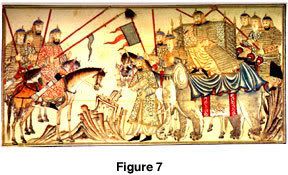
This can also bee seen in the Armenian version of the Battle of Vartanantz or Avarair (451 AD) (20). Yazdgerd II used war elephants effectively to defeat the army of Prince Vardan Mamikonian subjugating Armenia to Persian rule. In a medieval depiction of the battle (Figure 5) (21), the elephants were used “en mass” as mounts for archers and heavily armed soldiers similar to the Battle of Amida described by Marcellinius. (Note: As shown in Figure 5 each elephant appears to have one or two riders only and are massed together as a solid line.) On the other hand, Procopius, the other well know historian of Iranian wars (22) (490?- 562? AD), is totally silent about elephants. Thus, it can be assumed that while combat elephants were not crucial to the order of battle of the Iranian army, they were known and used when necessary to create a fear in the enemy and as support for infantry and cavalry.
In 620 AD, Khosrow II (also known as Khosrow Parviz) is depicted at Taq Bostan hunting wild boar in the swamps around Cestiphone (Detail in Figure 6a & 6b). The stone carving shows the king in the middle of a lake shooting wild boar with a bow from a boat, while being serenaded by singers in an adjacent vessel. Beaters riding elephants on the left hand side of the monument are chasing wild boars toward the king (Figure 6a) and game collectors on the right hand side, also riding elephants, are picking up the hunted game (Figure 6b).
The stance of the elephant rider in Figure 6a is significant. While in the “Mara Assault” (Figure 3) the rider is squatting on the back of the elephant; here, he is in a saddle sitting astride of the animal. The use of a “horse type” saddle is not possible with an Indian elephant. Only the mahout sits astride of the neck and all other persons either ride with the mahout on the elephant’s neck, squat on its back or ride on a mounted platform - a palanquin.
As seen in the bas-relief (Figure 6a) the relative ratio of the rider’s height to the elephant is also important. If the rider is assumed to be a five and a half feet tall, the elephant would be about six to seven feet high. Furthermore, the relative height of the elephant to the boar in the foreground would also confirm its height to be about seven feet. Also as seen in Figure 6b the boar is draped across the back of the elephant giving a further indication of its height and size.
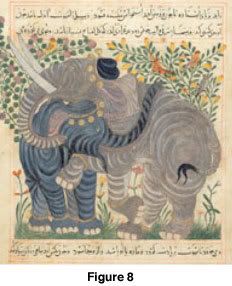
It is interesting that the entire panel shows some 20-25 elephants herding and collecting game for the king. It is hard to imagine that even Khosrow II (with all his power and reputed wealth) would import 25 selected small elephants from India, feed, maintain, and train them just to go hunting. It is more likely that he was utilizing an indigenous pygmy elephant population familiar with the region for his sport.
The Iranian army used elephants at the Battle of Qadesiyyah (634 AD), as reported by Muhammad ibn Jarir abu Jafar al-Tabari (838-923 AD), the Iranian historian. This history changing battle was fought southwest of present day Baghdad and established the Islamic Empire, signaling the collapse of the Sassanid Empire.
At Qadesiyyah, the Iranian general Rustam introduced elephants on the third day of combat to create a diversion. In this case elephants were not used “en mass” but were distributed singly among the Iranian forces. The Arabs and their allies did not have elephants in their order of battle (although they were aware of combat elephants as per Sura 105 “The Elephant” of the Koran (23 24).
The Arab commander, Sa'd ibn Abi Waqqas, using tactics that strongly resemble the battle plan of Renatus, orders his men to attack and injure the lead elephants, causing the animals to turn on their handlers and stampede into the Iranian troops. (It should be noted that the Iranian forces regroup after the event and continue to fight for a fourth straight day until a sand storm causes the defeat.) (25)
Again, al-Tabari, does not give a specific description (except reporting one as white) of the elephants at the battle of Qadesiyyah, but he does mention that the elephants had “sanadiq” as saddles. (“Sanadiq” in Arabic is the plural of “sandoq” which means “a chest or container or box”.) While sanadiq has been translated as “palanquins” it is more probably a heavy saddle on which the rider could, if necessary, stand. (26) (Although at one point al-Tabari mentions that there were twenty men riding every elephant, this is a gross exaggeration, since even Indian elephants could not support the weight of that many of troops) (27). It is very likely that all elephants at Qadesiyyah were from the same group depicted in Taq Bostan rather than imported elephants.
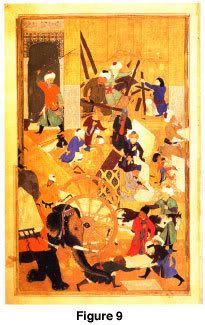
After collapse of the Arab caliphate, the Seljuk Empire (1037-1157) arose. This empire, which covered an area from China to Anatolia, was in power during the Crusades. Use of elephants in combat by the Seljuks has been recorded. Sultan Sanjar (died 1157) used elephants in his combat with Mahmoud of the Ghaznavid kingdom. He massed some 40 elephants in the battle for Saveh in north central Iran and again used 120 elephants in Ghazna in southeast Iran to win on both occasions. (28)
Skipping forward some 100 years to the Il-Khanid and their successors (1295-1478?) in the Middle East, there are actual drawings of elephants. In Rashid-ed-din’s tome, Jami’ al-Tawarikh, on world history (1295-1304 AD) there are five miniatures of elephants with the riders on “platforms”. As shown in the following miniature (Figure 7) from the book, Mahmud ibn Sabuktakin is riding “side saddle” on the elephant, not on a palanquin. This “saddle” could be stood on to observe the troops or used by archers, harkening back to the descriptions in al-Tabari and Figure 6. Figure 7 (29)
The elephant itself is again relatively small compared to either the riders or the horses and, interestingly enough, the elephant is covered with hair. While Rice, the editor, in his commentary suggests that the artist took liberty with drawings; this may not be the case. It could be that the artist drew what he saw – a hirsute, small elephant. The size, hair, ear shape and toe structure resembles a pygmy elephants rather than their larger Indian cousin.
Ibn Bakhtshu (1294-1299 AD) in his work “Manafi al Hayawan” shows two elephants mating (Figure 8). While these animals have the coloring of the Indian elephant (no hair and grey/blue coloring) (30), they are small when compared to the flowers and birds in the background. In other miniatures Ibn Bakhtshu maintains a relative scale between animals and it can be assumed that here also he would abide with the same convention.
Some years later, Timour or Tamerlane (1336-1405) used elephants extensively in combat and construction work. Timour grew up in central Asia and established his empire on the remains of the Mongol empire. Yet he knew how to utilize elephants in construction and combat.
Timour employed elephants in the construction of his great mosque in Samakand (31). While it is possible the 95 elephants used in Samarkand (in present day Uzbekistan) could have been imported from India, depiction of the work on the mosque by Behzad (1460-1535) does not verify this (32). This miniature (Figure 9) clearly depicts a small elephant when compared to the wheeled cart in the background. It is similar in size to the elephants depicted on the Seleucid coin in Figure 2.

Even though Timour’s armies were primarily tribal, light and mainly cavalry, yet when necessary, he could and did field heavy infantry and mixed forces. He also supplemented his own forces with the available regional forces (33). There are records of his use of elephants in India as well as in Anatolia, specifically in his attack on Allepo (in present day Syria). It should be noted that Timour, similar to his predecessors, used elephants effectively in combat showing a familiarity that only comes with usage. Elephants were not a novelty to him but a well-known weapon. Furthermore, military necessity or ceremonial events requiring the movement elephants over large distances were not uncommon at that time, (e.g. Hannibal and the Alps); and Timour, when required, could move large forces and their equipment. Yet, when the exigencies of war demanded, Timour’s ability to conscript and use local troops and their beasts should not be under estimated (34-35).
This said, according to Edward Gibbon, Timour led his attack on Allepo, Syria, with “…a line of Indian elephants, whose turrets were filled with archers and Greek fire…” (36). This would at least imply that, as far as Gibbon was concerned, Timour brought elephants all the way from India. However, the graphic in a serving plate (Figure 10) from the 1300 (Timourid Period) depicting the taking of a fortress by cavalry and infantry shows a single elephant (not a line) in combat. It is unfortunate that the image of the elephant rider has been destroyed but from the coloring and size of the elephant in comparison to the horses and warriors it would appear to be a pygmy rather than the Indian elephants that Gibbon mentions (see plate detail Figure 11) (37).

Uzun Hassan, ruler of the Aq-Quyunlu (1423-1478) in Azarbaijan, is reported by Venetian visitors to have pictures of elephant hunts in his palace, Hasht Behesht, in Tabriz. (38) The visitors are quoted as seeing scenes representing “…his hunting expeditions, on which he was accompanied by many lords, all on horseback, with dogs and falcons. There are also seen many animals like elephants and rhinoceroses, all signifying adventures which had happened to him…” (39). Elephant hunting in Azarbaijan would indicate that wild elephants were available in the area up to the 1400s. It should be noted that neither Marco Polo (1254-1324) (40) nor Ibn Battuta the Moroccan traveler of the (1325-1354) (41) mention elephants in the Middle East. (Marco Polo does refer to elephants from Indochina.)
Elephants also featured in the European medieval and renaissance paintings. They were generally given as gifts from ruler to ruler and were, sometimes, taken to combat, e.g., Charlemagne’s use of his gift elephant from Harun al Rashid against the Germanic tribes. Occasionally, crusaders also used captured elephants in war, but that seems to have been the exception rather than the rule. Thus, Europeans (while familiar with elephants and could draw them from life rather than concept) were not versed in elephant warfare. (42)
It is interesting that a European fresco (Figure 12) dated 1510 of Hannibal’s Alpine crossing shows a small elephant. Hannibal, in this painting, is riding on a “sandoq”, such as one that al-Tabari describes for the Battle of Qadesiyyah. No doubt considerable artistic license has been taken in this fresco (Hannibal is dressed as a Turkish Sultan and the soldiers are in Medieval apparel contemporary of the artist’s time), nevertheless the size and shape of the elephant is reminiscent of the Rashid-ed-din’s work. (43) It is possible that the painter had seen and drew a pygmy elephant?
Paintings from a slightly later period show enormous elephants, e.g., in Cornelis Cort’s painting dated 1567 of the Punic Battle of Zama-202 BC- between Rome and Carthage (Figure 13). While there is considerable artistic innovation in the portrayal of the scene, the elephants are massive compared to the men and horses! (44) This begs the question: were the two artists painting the same animal? Or had they seen different animals and were drawing what they saw? Or is it just wild imagination?
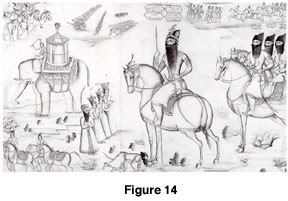
It should be noted that Iranian rulers throughout the centuries used elephants with a dexterity and adroitness in battle that implies complete familiarity with the creature. Elephants were not exotic items to be used on a whim, but were used with purpose and in conjunction with trained troops. This knowledge of the animal is reflected in Iranian poetry where they are repeatedly referenced both as royal transport and for war. (45) Usage of the term elephant “Fiel” or “Feel” by Persian poets indicates a familiarity with the animal that goes beyond conceptual or story telling. It can only come from real experience.
After about 1500 AD, Middle Eastern graphics start portraying Indian elephants with the appropriate dimensions and riding technique. Furthermore, armies and commanders in the Middle East ceased to use elephants in combat and they were no longer seen in the order of battle of the Iranian dynasties even when they were available. The elephant became a luxury item for used only in ceremonial events (46) and displays of power. The small elephants seem to have disappeared from the region along with the forests and trees. By the time of the Qajars in 19th century, only Indian elephants were available for ceremonial purposes (see Figure 14). (47)
So what happened? Where did these elephants go? As Obaid Zakani (1298?-1371) says:

(The elephant and the elephant rider were destroyed as was the treasure, the coins, the throne and the castle) (48)
Is it possible that over all these centuries artists consistently drew small elephants or were the elephants really smaller? Is it possible that the artist’s subjects were an indigenous pygmy elephant population that was being exploited for domestic and military use or hunting in the Middle East up to 1400 AD? And more importantly, if these animals existed, what could possibly have totally decimated them?
It is interesting that the disappearance of these elephants would coincide with the Turco-Mongolian invasion of Iran (starting in 1220) followed by the drop in average annual temperatures during the Little Ice Age in Europe (approximately between 1500 and 1850). Is it possible that these events are related?
The Turco-Mongolian invasion of Iran (other than massive destruction of the cities and villages) resulted in a major change in the land usage on the Iranian plateau. The Mongolian invasions disrupted the fundamentally agrarian tradition and changed it to a mixed herding/agrarian usage. Intensive, miagrational herding imposes a much higher environmental load and is destructive to vegetation. Herding and tribal land use, rather than sedentary agricultural use, imposed greater pressure on the plant life, especially since the herding was intensive and insensitive to the necessities of local fauna or flora.
Another factor maybe the Little Ice Age. The Little Ice Age in Europe is well documented (Figure 15) and it has been shown to have effected many things including changes in the type and variation of local flora (tree types in Europe actually changed) (49). During the Little Ice Age temperatures in Europe and North America fell, (ice caps and glaciers increased in size, trapping a considerable amount of atmospheric water) and, at the same time, temperatures in Western United States and the Middle East increased (50). The elevation of temperature and the possible concurrent drop in atmospheric humidity and reduction in annual precipitation could have contributed to the desertification of the area. (51) (see Note for detail on curves)

Total misuse of the local vegetation by intensive miagrational herding, the high population density of the Middle East and its demands of the environment would have caused the catastrophic collapse of the forests and vegetation already in jeopardy and fragile from the lack of rainfall. Decimation of the fauna dependent on the forest life would inevitably follow and could account for the disappearance of the elephant populations.
While it is possible that Indian elephants were used by the Iranian army at various times, this article proposes that an indigenous population of elephants, that was physically smaller, might have existed and could have been used in the Middle East until 1400 AD. The ability of commanders to employ elephants in combat and the integration of elephants in the order of battle of Iranian armies implies a common experience beyond novelty or sporadic use. This kind of intimate knowledge comes from daily continuous contact with local elephants over centuries rather than periodic contact with an import.
Characteristically, these “local” elephants were probably between 6 to 8 feet high, lived in forests and swamps, and were probably seasonally hirsute. These animals were used in combat, transportation, heavy labor as well as being hunted for sport. It is likely that habitat destruction caused human misuse and climate change induced by the Little Ice Age catastrophically reduced their numbers. Human exploitation of the elephant populations delivered the “coup de grace”. But then again maybe, as per Shakespeare, “a rose is a rose is a rose”..?
***
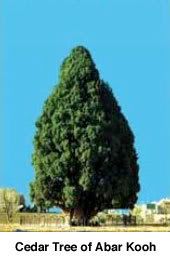
Cedar Tree of Abar Kooh “This tree is placed at the southwest of the city and its ancientness brings a historical importance for Abar Kooh. The age of this tree is estimated 4000 years or more. It has a thick stem, with 4.5m. diameter, 35m. high, and branches' thickness of 1.85m. Its perimeter is more than even if eight people circle it hand in hand.” (52)
NOTES
1) The Star: "Pygmy elephant in Sabah proven to be a new subspecies". See also BBC, "Borneo's elephants gain recognition"; The Hindu, "Pygmy elephants found in State forests?"
2) Wikipedia: "African Forest Elephant"
3) Caped Revenger: "Pygmy Elephant", and "Pygmy Elephant" by Eaton, Mathew J., Pygmy Elephant
4) Emmet Sweeney, "Animals and People on the Dier el Bahri Reliefs"
5) M. Masseti, "Did endemic dwarf elephants survive on Mediterranean islands up to protohistoric times"
6) Harper, Robert Francis. 1904. Assyrian and Babylonian Literature. Selected translations. New York: D. Appleton and Company.
7) Black Obelisk, British Museum, London
8) Bányai Michael, “The Arab Fringe”
9) Bible-history.com: "Ancient Historical Writings, Records of Assyrian Kings Found on Monuments"
10) The Anabasis of Alexander: The Battle of Gaugamela (Book 3, 7~16) By Arrian, Translated by E.J.Chinnock, & Gershevitch, Ilya ed., Cambridge History of Iran, Vol 2, Cambridge University Press, 1968 p 436
11) Yarshater, Ehsan, ed., Cambridge History of Iran, Vol 3, Cambridge University Press, 1968 p 824
12) Wikipedia: Seleucus I Nicator
13) Wikipedia: Satavahana or Andhras dynasty South Central India 230 BCE to 220 ACE, Mara's assault on the Buddha, 2nd century CE, Amaravati. Musee Guimet, Paris.
14 The Elephant in Rome: The Elephant in Rome
15) ibid
16) Ben Khader , Aicha ben Abed and David Soren, Carthage: A Mosaic of Ancient Tunisia, American Museum of Natural History, New York, 1987, pp 214-217
17) Wikipedia: "African Forest Elephant"
18) The Military Institutions of the Romans (De Re Militari), By Flavius Vegetius Renatus, Translated from the Latin by Lieutenant John Clarke, Text written in 390 A.D. British translation published in 1767. Copyright Expired
19) Ammianus Marcellinus, History Books 14-19, Loeb Classical Library, Harvard University Press, Cambridge, England, 2000, p 477
20) Yarshater, Ehsan, ed., Cambridge History of Iran, Vol 3, Cambridge University Press, 1968 p 521
21) Wikipedia: Battle of Avarayr
22) Procopius, History of the Wars Books I-II, Loeb Classical Library, Harvard University Press, Cambridge, England, 2001
23) Sura 105 “The Elephant” refers to the repelling of the attack of Abraha, King of Ethiopia, on the Ka’bah in 570 CE, the year of the birth of the Prophet.
24) Abrahamson, Ben and Joseph Katz, The Persian Conquest of Jerusalem in 614 BCE compared to the Islamic conquest 638 CE, p 15
25) Freidmann, Yohanan, The History of al-Tabari, The battle of al Qadesiyyah and the Conquest of Syria and Palestine, State University of New York Press, pp 82-122
26) ibid p82 and p89
27) ibid p93
28) Boyle, J.A. ed, Cambridge History of Iran Vol 5, Cambridge University Press 1968. p 120
29) Rice, David Talbot, The Illustrations to the World History of Rashid Al-Din, Edinburgh University Press, 1976, p39
30) Abu Sa'd' Ubayd-Allah ibn Ibrahim, known as Ibn Bakhtishu Manafi al-Hayawan (Uses of Animals), in Persian , Persia, Maragha, dated 1294, 1297, or 1299 335 x 250 mm Purchased by Pierpont Morgan, 1912 MS M.500 (fol. 13)
31) Dickens Mark, Timurid Architecture in Samarkand, P.10-11
32) Grabar, Oleg, Mostly Miniatures, An Introduction to Persian Painting, Princeton University Press, 2000, p 63, Figure 27
33) Manz, Beatrice Forbes, The Rise and Rule of Tamerlane, Cambridge University Press, 1993, p 33
34) Yezidi, Sharafudin Ali, Political and Military Institutes of Tamerlane, translated by Major Davy in 1782, Idarah-I Adabyat-I Delli, 1972, p 52 (Sharaf ad-Din Ali Yazdi, Persian Historian 15th century AD)
35) Manz, Beatrice Forbes, The Rise and Rule of Tamerlane, Cambridge University Press, 1993, p 105
36) Gibbons, Edward, The Decline and Fall of the Roman Empire, Fred De Fau & Co, New York, 1907, Vol 11, Ch 65, p 197
37) Grabar, Oleg, Mostly Miniatures, An Introduction to Persian Painting, p 41 Figure 9
38) ibid pp 21 and 22
39) Lauren, Samantha, Painted interiors from the Houghton Shahnameh, Thesis submitted to the Program in Asian Studies Florida State University, Fall 2004, Chapter 5, pp 18
40) Komroff, Manuel, Travels of Marco, Polo, Boni and Liverright, reprinted 1930, p 270
41) Dunn, Stephan, The Adventures of Ibn Battuta: A Muslim Traveler of the 14 the Century, California Press 1989
42) Wikipedia: History of elephants in Europe
43) Wikipedia: Punic Wars
44) Wikipedia: Battle of Zamapainting
45) Yarshater, Ehsan, ed., Cambridge History of Iran, Vol 3, Cambridge University Press, 1968 p 410
46) Melville, Charles, Ed., Safavid Persia, Vol. 4, I.B. Taurus & Co ltd, 1996, p 166
47) Robinson, B.W., et al, Royal Persian Paintings, I.B. Taurus, London 1999, p 73 Figure 24
48) Obaid Zakani, The Story of the Mouse and the Cat, Bank Melli Press, Tehran 1972, p 25
49) The Little Ice Age In Europe, Scott A. Mandia
50) Mann, Micheal E. Little Ice Age, Encyclopedia of Global Environmental Change, John Wiley and Sons 2002, pp 504-509
51) 2000 Year Temperature Comparison, Note: The different color lines show annual temperature estimates from different sources.
52) YazdCity.com: Abarkooh
www.iranian.com/History/2007/January/Elephant110/index.html